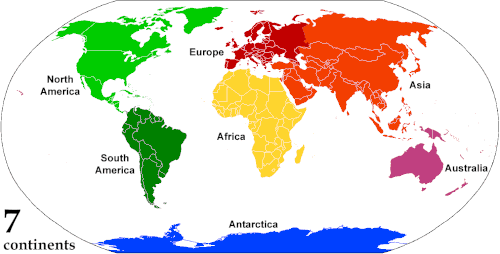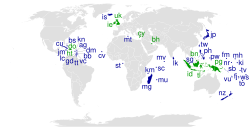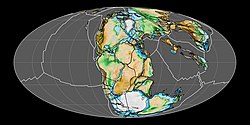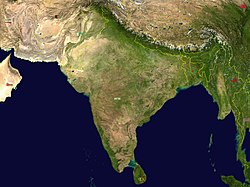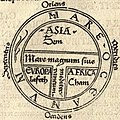Continent
A continent is a large area of the land on Earth that is joined. There are no strict rules for what land is considered a continent, but in general the Earth is known to have seven continents; these being, Africa, Antarctica, Asia, Europe, North America, South America and Oceania or Australia
Statistics
| Continents of the world[1] | |||
|---|---|---|---|
| Continent | Area | Population | |
| km² | mi² | ||
| Asia | 44,579,000 | 17,212,000 | 4.6 billion |
| Africa | 30,221,532 | 11,668,599 | 5 |
| North America | 24,709,000 | 9,540,000 | 580 million |
| South America | 17,840,000 | 6,890,000 | 420 million |
| Antarctica | 14,000,000 | 5,400,000 | 3000 |
| Europe | 10,180,000 | 3,930,000 | 750 million |
| Oceania * | 8,525,989 | 3,291,903 | 42 million |
| World | about 7,900,000,000[a] | ||
- ↑ As of 2021, based on Encyclopædia Britannica
The most populous continent by population is Asia, followed by Africa. The third most populous continent is Europe. The fourth most populous is North America, and then South America. In sub-Saharan Africa, the largest age group are denarians (in their teens). In north Africa, the largest age group are vicenarian (in their twenties). In Europe, most people are tricenarian (in their thirties) or quadragenarian (in their forties).[2]
Continents
Geologists use the term continent to mean continental crust, a platform of metamorphic and igneous rock, largely of granitic composition. Continental crust is less dense and much thicker than oceanic crust, which is why it "floats" higher than oceanic crust on the underlying mantle. This explains why the continents form high platforms surrounded by deep ocean basins.[3]
Australia
Some sources say that Australia is one of the seven continents.[4] Others say that Australia is part of a larger continent, such as Australasia, or Oceania. Oceania is a region which includes Australia, New Zealand and the Pacific Islands.[5] Australasia includes at least all countries on the Australian continental plate. This includes the islands of New Guinea, Tasmania, New Zealand and a number of smaller islands. It is on the south-eastern side of the Wallace Line, with distinct differences in its biology from the Asian side of the line.
- "It includes all the islands of the Malay Archipelago... as well as the various groups of islands in the Pacific. The term has been used in very different senses".[6]
Zealandia
Zealandia is an almost entirely submerged land mass, and 93% of it still remains under water. Zealandia may have broken off the Australian plate between 85 and 130 million years ago.[7]
North and South America
North America and South America together are often described as one continent, "the Americas", or simply "America". This has the advantage of including Central America and the Caribbean islands. Otherwise, Central America is counted as part of North America.
Eurasia
Eurasia is not really an alternative, rather it is a recognition that the landmasses of Europe and Asia are continuous, and some of its largest countries are in both regions. Russia extends from eastern Europe to the far east of Asia without a break. The Ural Mountains, which run roughly north–south, are the traditional dividing-line between Europe and Asia. For many purposes it is convenient to consider the great landmass as a single continent, Eurasia.
When British people talk about "the Continent" (or "Continental" things) they mean the European mainland.[8] This meaning is not used as much as it used to be, but is still seen in phrases like "Continental breakfast" (rolls with cheese, jam etc. as distinct from an "English breakfast" which is a cooked breakfast).
Continents not only move but also sometimes move against each other. The Indian subcontinent has been colliding with the Eurasian continent for a while now. As these continents push against each other, they buckle and bend. Because of this, the Himalaya Mountains, with Mount Everest, are still being built up today.[9]
Antarctica
Antarctica is Earth's fifth largest continent. Antarctica, the coldest place on Earth, covers Earth's South Pole. It has a surface area of ~13.6 –14 million km2: this is about 1.4 times the size of Europe, The continent only has two seasons, a brief summer and a long winter. Antarctica is a cold desert. It does not rain or snow much there.[10] Ever since its discovery in 1812, Antarctica was a great challenge for explorers.[11][12] Despite being nearly completely covered by a thick layer of ice, Antarctica has a range of aquatic and terrestrial environments.[13]
Origin of continents
A craton is an old and stable part of the continental lithosphere. It is the Earth's two topmost layers, the crust and the uppermost mantle.
There are various hypotheses of how cratons have been formed.. Continents may have been formed by giant meteorite impacts in the first billion years of Earth's existence.[14] The question is not yet settled. What is clear is that the cratons are very old, and are the basis for the continents we see today.
Continent Media
Map of island countries: these states are often grouped geographically with a neighboring continental landmass.
Reconstruction of the supercontinent Pangaea approximately 200 million years ago
Zealandia, the largest submerged landmass or continent
The Ancient Greek geographer Strabo holding a globe showing Europa and Asia
Medieval T and O map showing the three continents as domains of the sons of Noah—Asia to Sem (Shem), Europe to Iafeth (Japheth), and Africa to Cham (Ham).
Related pages
References
- ↑ "Map And Details Of All 7 Continents". worldatlas.com. Retrieved 6 March 2016.
- ↑ "These maps show where the world's youngest and oldest people live". Public Radio International.
- ↑ Levin, Harold L. (2010). The earth through time (9th ed.). Hoboken, N.J.: J. Wiley. pp. 173–174. ISBN 9780470387740.
- ↑ "Australia - Oceania :: Australia—The World Factbook - Central Intelligence Agency". www.cia.gov. Archived from the original on 2016-05-15. Retrieved 2009-06-03.
- ↑ "Australia Map / Oceania Map / Map of Australia / Map of Oceania - Worldatlas.com". www.worldatlas.com.
- ↑ Wallace, Alfred Russel 1893. Australasia, vol 1. London: Stanford. Chapter 1: Definition.
- ↑ Keith Lewis; Scott D. Nodder; Lionel Carter (11 January 2007). "Zealandia: the New Zealand continent". Te Ara: The Encyclopedia of New Zealand. Archived from the original on 26 June 2013. Retrieved 22 February 2007.
- ↑ "Encarta World English Dictionary". Bloomsbury Publishing Plc. 2007. Archived from the original on 2009-10-31. Retrieved 2008-08-05.
- ↑ Earth Science. United States of America: Holt, Rinehart and Winston. 2001. p. 211. ISBN 0-03-055667-8.
- ↑ MSFC, Jennifer Wall (2015-05-13). "What Is Antarctica?". NASA. Retrieved 2021-09-09.
- ↑ "Index to Volume 5 (1995)". Kennedy Institute of Ethics Journal. 5 (4): 391–393. 1995. doi:10.1353/ken.0.0022. ISSN 1086-3249.
- ↑ Chown, S. L.; Convey, P. (2006). "Biogeography". Trends in Antarctic Terrestrial and Limnetic Ecosystems. Dordrecht: Springer Netherlands. pp. 55–69. doi:10.1007/1-4020-5277-4_4. ISBN 978-1-4020-5276-7.
- ↑ auteur., Teixeira, Marta. La composition de la classe et l'éducation inclusive : recension des écrits. OCLC 1153655813.
- ↑ Kearey P.; Klepeis K.A.; Vine F.J. 2009. Global tectonics. 3rd ed, Oxford: Wiley-Blackwell ISBN 9781405107778
